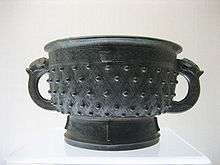Da Yu ''ding''
| Da Yu ding | |
|---|---|
| 大盂鼎 | |
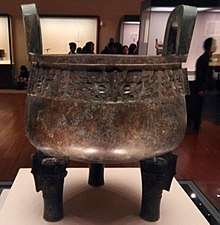 The Da Yu ding is exhibited in the National Museum of China. | |
| Material | Bronze |
| Height | 101.9-centimetre (40.1 in) |
| Width | 77.8-centimetre (30.6 in) |
| Weight | 153.5-kilogram (338 lb) |
| Created | 1054 BC |
| Discovered |
1849 Li Village, Mei County, Shaanxi |
| Present location | National Museum of China |
The Da Yu ding (Chinese: 大盂鼎; pinyin: Dà Yú dǐng) is an ancient Chinese bronze circular ding vessel from the Western Zhou dynasty (1046–771 BC).[1] Excavated in Li Village, Mei County, Shaanxi, it is on display in the National Museum of China.[2]
The Da Yu ding, the Da Ke ding in the Shanghai Museum, and the Mao Gong ding in the National Palace Museum in Taipei are famous bronze dings.
Description
The tripod is round, with three legs, a common shape during the Western Zhou dynasty. It is 101.9-centimetre (40.1 in) high and weighs 153.5 kilograms (338 lb). Its aperture is 77.8-centimetre (30.6 in). Its mouth was engraved with Taotie patterns and its four legs was engraved with animal face patterns. The king is attributed to King Kang of Zhou (1020–996 BC), and the date is attributed to the 23rd Year of the king, the Western Zhou dynasty(1046–771 BC) [3]
Inscription
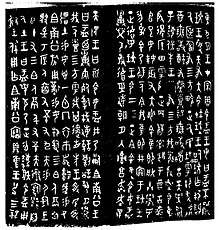
The tripod has 291 Chinese characters in 19 lines inside the tripod[4]. Most is The King's Speech. 1st speech is a Historical Overview in which he provides a moral rationale for the fall of the Shang dynasty (c. 1600–1046 BC) and the rise of the Western Zhou. Here, the King said that the excess of drinking wine made Yin dynasty had lost the heaven grace and army. And the Kings of Zhou have not excess drinking in even ceremonial scenes. And, the King commands Yu(盂). support the King, and work official service throughout days. The 2nd is a short charge to Yu to emulate his late grandfather, Nang Gong. The 3rd is the appointment of king's minister with army power. And the detailed inventory granted by the King. At last, Yu himself recorded that he made this tripod for his deceased grandfather Nang Gong in response to the kings kindness. It was the king's 23th year[5][6]. The 1726 slaves in the inventory, is an important historic material for studying slavery.
History
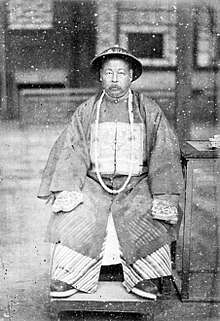
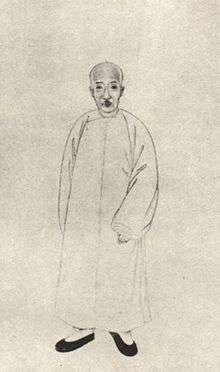
In the Daoguang era (1821–1851) of the Qing dynasty (1644–1911), this tripod was unearthed in Li village, Mei County, Shaanxi. Song Jinjian (宋金鉴; 宋金鑒; 1821–1863), a local rich man, acquired it. Next, the governnor Zhou Gengsheng (周庚盛) expropriated it. After he died, Song Jinjian recovered the tripod [7].
Before 1873 winter, Yuan Baoheng (袁保恒; 1826–1878), a follower of Zuo Zongtang bought it at a price of 700 tael of silver[8]. Yuan might send the tripod he bought to Zuo Zongtang. In 1875[9], Zuo Zongtang presented the tripod he treasured as a gift to Pan Zuyin((潘祖荫; 潘祖蔭;; 1830–1890) in Beijing[10]. Pan Zuyin was a famous collector with rich knowledge in Chinese characters. In 1890, Pan acquired the Da Ke ding, the second largest bronzeware of the Western Zhou dynasty after the Da Yu ding. His younger brother Pan Zunian (潘祖年; 1870–1925) inherited the family property. In about 1896, Pan Family moved to Suzhou from Beijing with their collection including two tripods.
In 1937, the Second Sino-Japanese War broke out. Fearing looting or destruction, Pan family packed the two tripods in a wood box and buried it in the earth.
In 1951, Pan Dayu(潘达于; 潘達于; 1906–2007) donated the two tripod to the nation. [11] Shanghai Museum displayed the two tripods and published [12]. In 1959, the Da Yu ding was transferred to Beijing and became one of the most valuable treasure in National Museum of China. In March 2004, in order to celebrate Pan Dayu's 100 birthday, the Da Yu ding was transferred to Shanghai Museum for a special and short display. It's their reunion for half a century.[13][14]
See also
Notes
- ↑ Qiu Xigui (2000), p. 68.
- ↑ Li Song (2015), p. 30.
- ↑ Shanghai Museum 1959
- ↑ Da yu Ding Chinese Rubbing Collection Harvard University, USA WEBsite
- ↑ Jeffrey R. Thersen 2015 103-127p
- ↑ Robert Eno, Indiana University Document
- ↑ record in Shaanxi Epigraphy(陕西金石志, 1934) in Shanghai Museum 1959. Another record showed the owner another Ko family. there is controversy
- ↑ Wu Dacheng(1835-1902) appreciated and recorded the tripod in Yuan's estate in Shaanxi in 1873 winter.
- ↑ On the letter at 1875 March (Guangxu Emperor era 1st year January(Chinese calendar) 11th) from Chen Jieqi(1813-1884) to Pan Zuyin
- ↑ Shanghai Museum 1959
- ↑ Pan Dayu wrote a short letter, intending to donate the two tripods to Shanghai Museum. A few months later, Liu Ruli (刘汝醴; 劉汝醴) and Shen Gengmei (沈羹梅) went to Suzhou accompanied by Pan Jiahua (潘家华; 潘家華), daughter of Pan Dayu, to take the tripods. Mao Dun (1896–1981), the Minister of Culture, personally inscribed an honorary credential for her.
- ↑ Shanghai Museum 1959
- ↑ 大克鼎和大盂鼎:半世纪后再聚首 [Da Yu ding and Da Ke ding: reunited after half a century]. sina (in Chinese). 2004-03-02.
- ↑ 国宝级文物大盂鼎大克鼎五十年后上海相聚 [National treasures the Da Yu ding and Da Ke ding are reunited half a century later in Shanghai]. Tencent (in Chinese). 2004-02-09.
References and External links
- Qiu Xigui (2000). Chinese Writing. Early China Special Monograph Series No. 4. Translated by Gilbert Mattos; Jerry Norman. Berkeley: The Society for the Study of Early China and the Institute of East Asian Studies, University of California, Berkeley. ISBN 1-55729-071-7.
- Li Song (2015). Chinese Bronze Ware: A Mirror of Culture. Beijing: China Intercontinental Press. ISBN 9787508533766.
- Shanghai Museum, YU DING KE DING. ('Yu' Vessels and 'Ke' Vessels)(Chinese Text). Shanghai, 1959.
- Da yu Ding Chinese Rubbing Collection Harvard University, USA
- Robert Eno, Inscriptional Records of the Western Zou, 2012 23-24p, Indiana University SITE, Bloomington, USA
- Jeffrey R. Thersen, CHINESE EUPHONICS :PHONETIC PATTERNS, PHONORHETORIC AND LITERARY ARTISTRY IN EARLY CHINESE NARRATIVE TEXTS, Ph. D Dissertation in Department of East Asian Department, University of Chicago, 2015, Dec, Chicago, Illinois, USA
- Christian Deydier (2016). 《读懂中国青铜器:文化、形式、功能与图案》 [Understanding Ancient Chinese Bronzes: Their Importance in Chinese Culture, Their Shapes, Functions and Motifs] (in English and Chinese). Beijing: Yilin Press. ISBN 9787544752114.
- 《中国青铜器全集:西周》 [Complete Works of Chinese Bronze Wares: Western Zhou Dynasty] (in Chinese). Beijing: Cultural Relics Publishing House. 2005. ISBN 9787501008971.
- Jin Weinuo (2010). 《中国美术全集:青铜器》 [Complete Works of Chinese Art: Bronze Ware] (in Chinese). Anhui: Huangshan Publishing House. ISBN 9787546113722.
- Liu Wei; Duan Guoqiang; Peng Shifan (2016). 《中国艺术史图典·青铜器卷》 [History of Chinese Art: Bronze Ware] (in Chinese). Shanghai: Shanghai Lexicographical Publishing House. ISBN 9787532647958.
